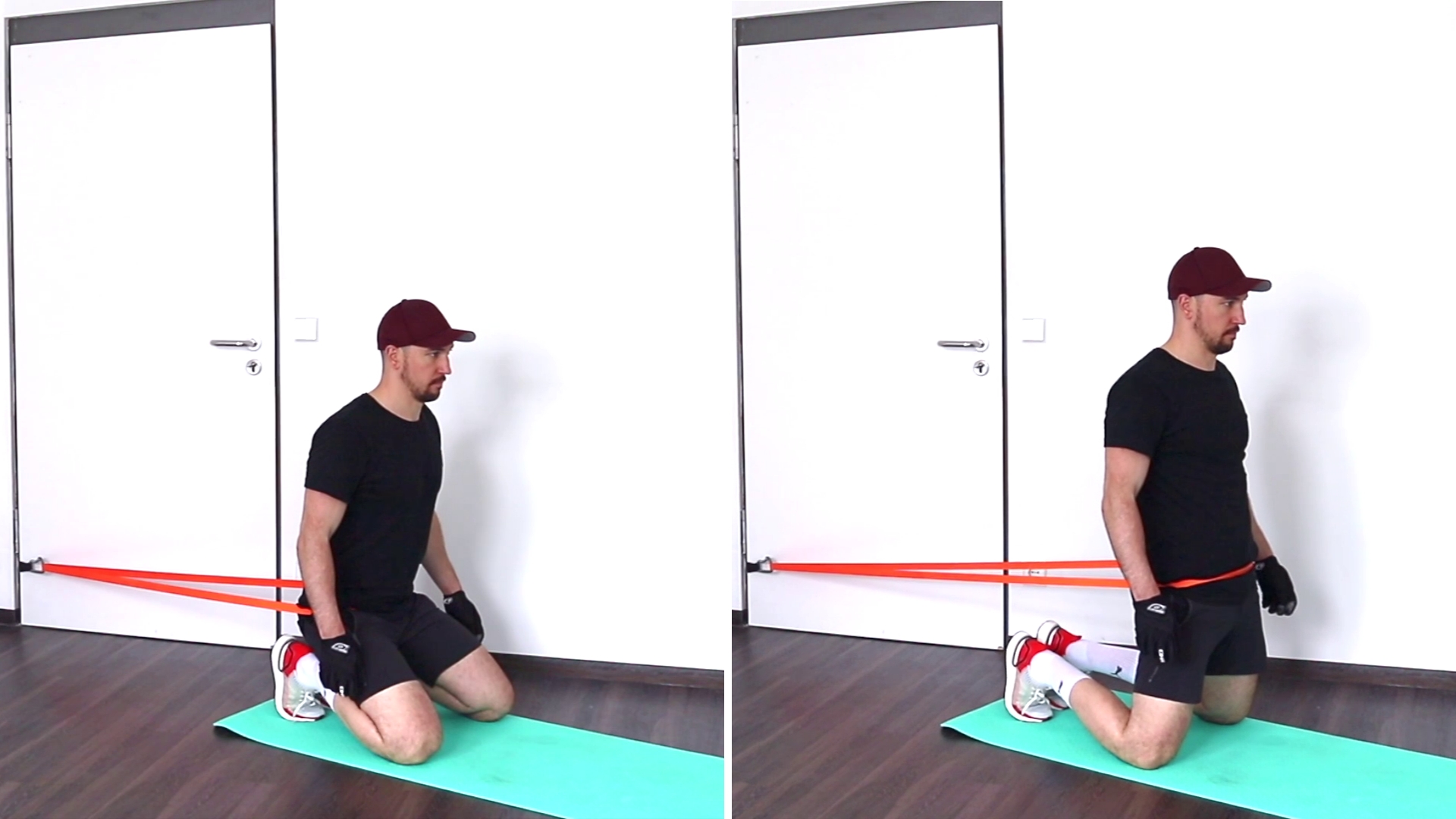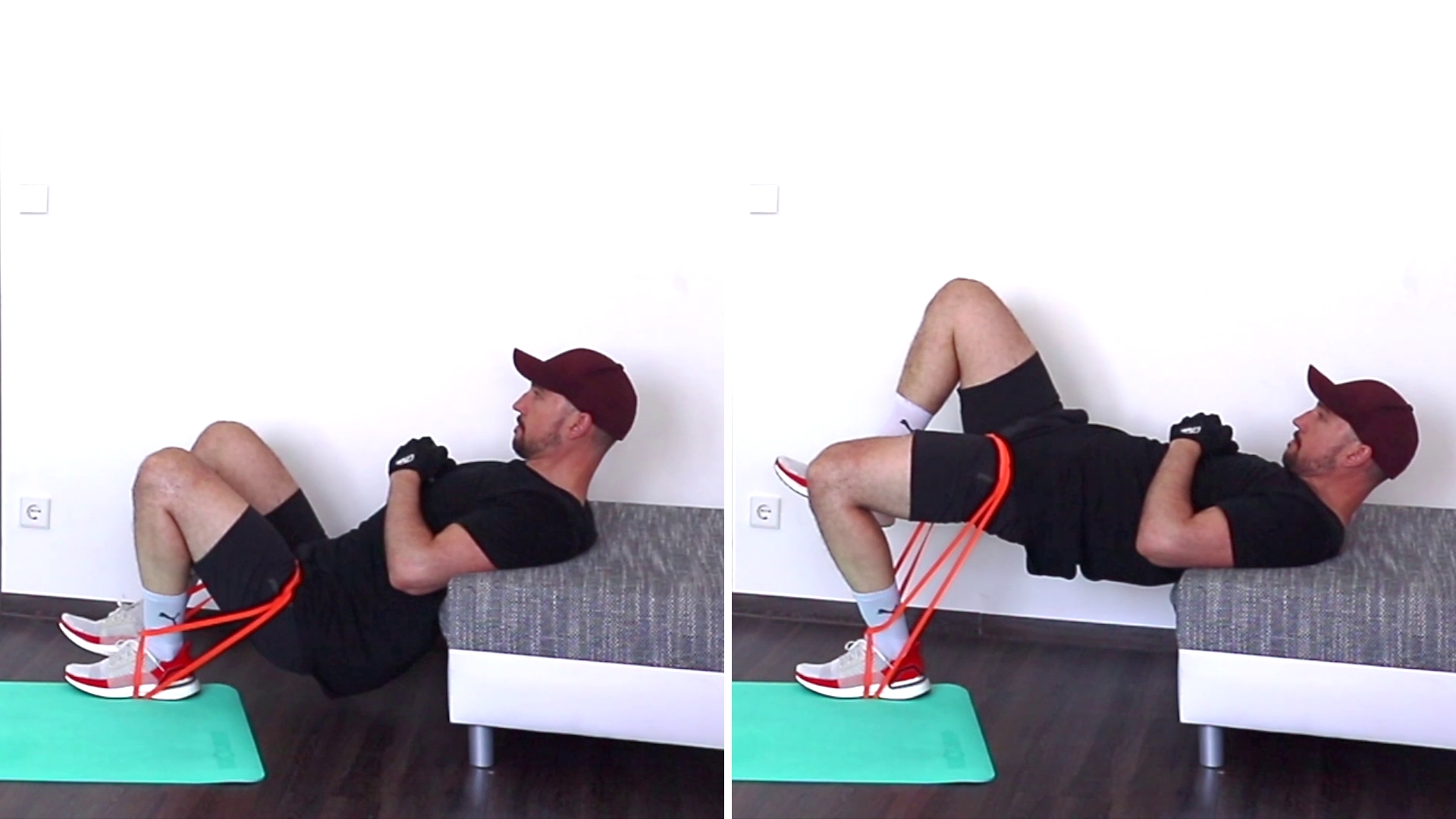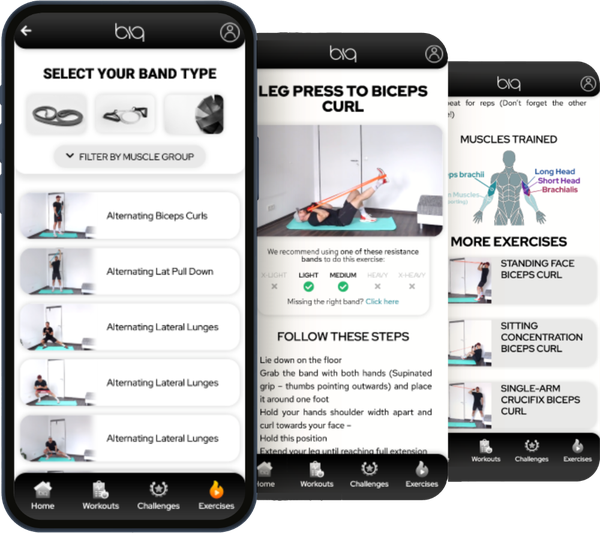Hip Thrusts are great to target your glutes directly. Exercises like deadlifts and squats should still be the foundation of your lower body workouts. By adding hip thrusts, you will be able to get some extra focus on your glutes. Doing that will make sure that you reach your goal, be it more size or greater strength.
The great thing is that the only piece of equipment you’ll need is a set of resistance bands. Not a lot of weight, no gym membership or expensive machines. Simple resistance bands. In case you still need a set to get started, check out our set right here: Resistance Bands Set
In this article you will learn what steps there are in a perfect hip thrust as well as what Dos and Don’t there are. Also, we will cover how to adjust the resistance of a given band.
You can deepen your knowledge by reading the section about how effective working out with resistance bands actually is and what advantages there are by training with resistance bands.
Last but not least, we will show you our most favorite variations of hip thrusts and a way to incorporate them in your workout routine.
How To Hip Thrust The Right Way With Resistance Bands?
Warming up is always the first step before doing any exercise with an additional load. By doing so, you will be making faster and better progress, since you will prevent injury. Warm muscles perform better, and prepared joints will handle resistance with ease.
And remember, it is not about pleasing your ego. Form should be always your number one priority, make sure to really nail it. Start with a low resistance and work your way up.
When it comes to hip thrusts, there are some Dos and Don’ts which you should follow to really get the form right and have a killer workout. Check them out further below.
Step-by-step guide for the 100% correct hip thrust with resistance bands:
- Find a sturdy object which is around knee height (Bench, couch, …)
- Double up the band and step with each foot inside the small loops on each side
- Place your upper back on the sturdy object and place the band on your hips
- Start in the bottom position
- Raise your hips towards the ceiling until fully extended
- Return slowly to the starting position (resist against the pull of the band)
- Repeat for reps
Important Dos & Don’ts!!!
⓵ Keep your upper body straight! – Often people forget about their upper body when training the lower body. Your upper body always plays an important role in any lower body exercise, and this is stabilization. When it comes to hip thrusts, make sure to keep a neutral neck position by tucking your chin and a straight lower back. To reach that, contract your ab muscles consciously.

⓶ Really SQUEEZE your butt cheeks together in the top position! – The main player in hip thrusts are your glutes. The glutes are what we are training here. To really get them working and feel that they are working, make sure to actively squeeze your glutes. Especially in the top position, really contract them!
These are specific mistakes you should avoid when it comes to do hip thrusts. But there are also some general mistakes to avoid when working out with resistance bands. To really get everything right, check out our article on this topic:
The Worst Mistakes You Can Do When Training With Resistance Bands
How To Adjust The Resistance
Often people do a big mistake when it comes to adjusting the resistance with resistance bands. And this is jumping to the next heavier band when the exercise gets a bit easier with the band they are using right now. You might think it is logical to get the next heavier weight, since it is what you would do when training with weights. But bands are different. Resistance bands have a variable resistance – this means the further you stretch a band, the more pull it will create – so the load increases with the distance bands are stretched. This means jumping to a heavier band is often too much and this often results in form breakdown – which can lead to injury.
This is easily avoided when you know how to manipulate the resistance of a given resistance band and get the most out of it. Great methods to adjust the resistance of a given band when doing hip thrusts are:
Adjust the length of the band – This method is the base of adjusting resistance of resistance bands. Make it shorter. The shorter the band is, the higher the resistance will be. How to do that? Simple – Wrap it!
For hip thrusts, it is the best way to wrap the band around one of your feet.
Combine bands – We highly recommend you getting a set of resistance bands and not only one. This way you will be able to train your whole body with the right resistance as well as combining bands of different resistance to get the right resistance. The best way to use this method is simply adding the lightest band to your next workout and see if you are still able to do hip thrusts with perfect form.
Slow it down – adding resistance is not the only way to make an exercise harder. Simply slowing your reps down will increase the intensity drastically. Your muscle will have to work harder and this will result in training progress.
Of course, you can combine all the techniques as well. Slow down your reps and add a light band or shorten it in your next workout. This way you will always be able to get the 100% right resistance.
The BIQ App
Take training with resistance bands to the next level with our free app.
- 800+ Exercises
- all band types
- different training goals & workouts
- challenges
- much more
Alternative Ways To Hip Thrust With Resistance Bands
Variations are great to simply change it up and keep your workouts interesting. Sometimes they are harder or easier. Or there is a slightly different muscle group focus. The following 3 variations are the best when it comes to hip thrusts!
Kneeling Hip Thrust – This variation is great for beginners. You will be in an upright position and stability will be less challenging compared to the horizontal version shown above. Once you reach a certain resistance level, you will have to change the variation, since the band will be likely pulling you backwards.

How to do it: Place something soft underneath your knees to make it comfortable. A yoga mat, a towel or simply socks will do.
- Attach the band towards the bottom of a door with a door anchor
- Get inside the loop and place the band on your hips
- Step forward until you feel tension in the band and get on your knees
- Start in the bottom position
- Push your hips forward until fully extended
- Return slowly to the starting position (resist against the pull of the band)
- Repeat for reps
Pull Through – a great alternative to hip thrusts are pull throughs. this exercise is great since you will be doing it standing up, so there is less stability work to be thinking about. In pull throughs your hamstrings will do less work compared to your glutes.

How to do it:
- Attach the band towards the bottom of a door with a door anchor
- Get inside the loop and place the band on your hips
- Step forward until you feel tension in the band
- From the standing position, drive your hips backwards while having your legs almost straight
- Reverse the movement and drive your hips forward until you reach a full standing position again
- Repeat for reps
Single-Leg Hip Thrust -This variation is great to make it interesting and challenge your stabilization at the same time. By doing hip thrusts with one leg at a time, you will really overload that working side, and you can do that with a lighter resistance band.

How to do it: The basic form is identical to the hip thrust with two legs. In this variation, you will fix the band under only one of your feet and bring it over the knee of the same leg. The other leg you will hold in the air throughout the set.
Can You Train Hip Thrusts Effectively With Resistance Bands?
When it comes to hip thrusts I actually like to do them with resistance bands much more than with weights. It takes so little time to set up the exercise and I feel the glutes working much more compared to doing hip thrusts with weights.
A lot of people simply never tried training with bands and just don’t know how much load they actually can create. Band are not easy. With the right exercise set up and the right techniques to adjust the resistance I would argue that resistance bands are actually superior to any other method of working out.
So don’t let be fooled! Resistance bands are a great tool to become more fit and make progress. Keep on reading, and you will find out why and benefits you can reap by using them.
Why Does Training With Resistance Bands Work
We are programmed by media that you need weights to create a good body. But actually you need resistance. Our muscles don’t know the difference between resistance created by gravity and weight or by resistance bands.
All our muscle know and respond to is resistance.
So as long as your muscles have to work against a load they will get a stimulus to grow and will with time be able to handle greater and greater loads.
To get in depth information about this topic check out our full article: Why Does Training With Resistance Bands Work
Benefits Of Training With Resistance Bands
Actually there are a great number of pros to working out with resistance bands instead of weights and machines. Some are:
- Variable Resistance. The further you stretch a resistance band the higher the resistance will be. This way you can use one band to have a whole set of weights.
- Fewer Injuries! Resistance bands are easier on the joints compared to weights. This will reduce the chance of injury.
- Workout Anywhere! Small, handy and light. You can work out anywhere and safe time by not having to got to the gym. And safe money at the same time!
Check out our full article on this topic: Benefits Of Resistance Band Training
What Muscles Are Used In A Resistance Band Hip Thrust
Hip thrust target primarily the glutes. The hamstrings will also be working quite hard. Since you have to keep a stable upper body, your core muscles will be working throughout the whole movement.
Main Working Muscles:
- Glutes
- Hamstrings
Support Muscles:
- Quadriceps
- Core Muscles
- Lower back – Spinal Erectors
Workout Plan
Hip thrusts are perfect to target your glutes and get some hamstring work done, but one exercise alone won’t make a great workout. The best thing to do is incorporating an effective workout program into your week, which will target all muscles of your body.
Since construction a good workout routine is not that simple and can sometimes be quite annoying, we did it for you. This way you can dive straight into working out instead of reading through a lot of text or watch a bunch of videos.
In our BIQ Training App we have several workout routines you can follow along. You can customize your routines depending on your goals. With this app you will also have a library of all resistance band exercises with a step by step description and a how-to video in your pocket – available all the time. Find out more here: BIQ Training App


